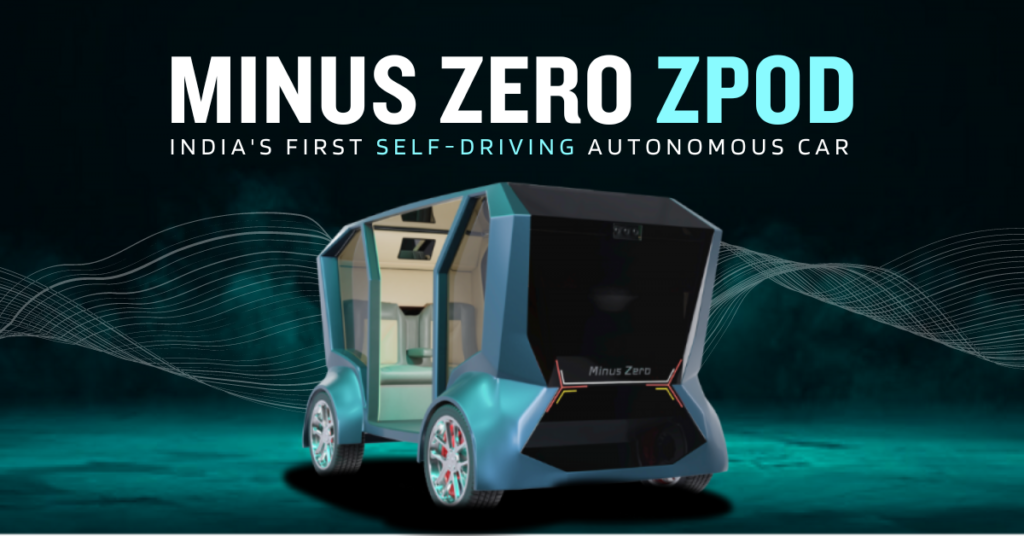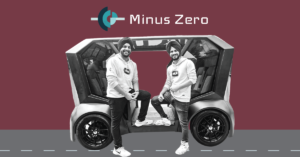Transforming Mobility in India with Nature-Inspired AI: Minus Zero’s Autonomous Vehicle Revolution

 Artificial Intelligence (AI) technology has been a driving force behind the evolution of mobility solutions, and Bengaluru-based startup Minus Zero is at the forefront of this transformation. Founded by Gagandeep Reehal and Gursimran Kalra in 2020, Minus Zero is rewriting the future of mobility in India with its innovative AI-driven approach. At the heart of their groundbreaking efforts is the zPod - India's first fully autonomous vehicle. In this article, we delve into how Minus Zero is leveraging Nature-Inspired AI to revolutionize autonomous mobility in India and beyond.
Artificial Intelligence (AI) technology has been a driving force behind the evolution of mobility solutions, and Bengaluru-based startup Minus Zero is at the forefront of this transformation. Founded by Gagandeep Reehal and Gursimran Kalra in 2020, Minus Zero is rewriting the future of mobility in India with its innovative AI-driven approach. At the heart of their groundbreaking efforts is the zPod - India's first fully autonomous vehicle. In this article, we delve into how Minus Zero is leveraging Nature-Inspired AI to revolutionize autonomous mobility in India and beyond.
The Rise of Nature-Inspired AI:
India's unique road conditions, characterized by unpredictable traffic and chaotic roadways, have posed significant challenges to the development of autonomous vehicles. However, Minus Zero has tackled these challenges head-on with Nature-Inspired AI (NIA), a revolutionary concept that draws inspiration from the decision-making capabilities of the human brain and physics-aware vision. NIA is the driving force behind Minus Zero's quest to make AI more adaptable and efficient in real-world scenarios.
NIA: Representation, Prediction, and Adaptation:
To make AI more human-like, Minus Zero employs a three-pronged approach: representation, prediction, and adaptation. Unlike traditional AI, which stores massive amounts of data, NIA focuses on understanding correlations between data points. For instance, if a human slips on a wet surface, their brain prioritizes understanding the correlation between water and slipping rather than memorizing specific incident details. Minus Zero applies this concept to AI, enabling it to identify correlations, make predictions, and adapt to new information, much like a human would.
The zPod: India's Autonomous Vehicle Pioneer:
At the heart of Minus Zero's AI-driven revolution is the zPod. This fully-electric prototype represents a quantum leap in India's autonomous vehicle journey. What sets the zPod apart is its ability to achieve Level 5 autonomy - the highest level where a vehicle can operate entirely without human intervention in any driving conditions. This achievement is made possible by the zPod's reliance on Nature-Inspired AI, which equips it to handle India's unique and challenging road conditions.
Camera-Based Sensory System:
Unlike many autonomous vehicles that rely on expensive sensor arrays like LIDAR, the zPod leverages a network of strategically positioned high-resolution cameras. These cameras capture real-time images of the vehicle's surroundings, transmitting them to the AI system for processing. This camera-based approach not only makes the zPod more affordable but also better suited to the dynamic and unpredictable Indian traffic landscape.
The Versatile Use Cases of zPod:
In its initial deployment phase, the zPod is primarily focused on in-campus mobility. This involves transporting individuals within the confines of specific campuses or controlled environments, such as tech parks, university campuses, and corporate facilities. However, Minus Zero's ambitions extend far beyond the zPod as a standalone vehicle.
Beyond the zPod: Minus Zero's Vision:
It's essential to understand that the zPod is not meant to be a production vehicle for Minus Zero. Instead, it serves as a technological showcase of the advanced AI-based autonomous vehicle technology they have developed. Minus Zero's founders believe that achieving the full potential of autonomous vehicles requires collaboration across the industry ecosystem, emphasizing that they are not an original equipment manufacturer (OEM) and have no plans to build cars themselves.
Advancing Mobility with NIA and TVA:
Minus Zero's commitment to advancing mobility technology is reflected in its proprietary technologies: Nature-Inspired AI (NIA) and True Vision Autonomy (TVA). NIA offers real-time, low-power processing, adaptability to uncertain or chaotic real-road conditions, and eliminates the need to re-learn driving for different use cases, geographies, or vehicles. TVA, a vehicle-agnostic technology, relies solely on cameras as its sensor suite, ensuring safe navigation in real-world scenarios.
Conclusion:
As India embraces the future of autonomous mobility, Minus Zero stands as a shining example of innovation. Their pioneering efforts in Nature-Inspired AI and the development of the zPod showcase the potential for safer, more adaptable, and affordable autonomous vehicles tailored to the intricacies of Indian roads. While the zPod represents a significant milestone, Minus Zero's vision transcends the vehicle itself. It's a vision of collaborative transformation, where AI-driven technology redefines mobility as a user-focused experiential design. With Minus Zero leading the way, we can anticipate a future where AI-powered autonomy revolutionizes mobility across India and the globe.
“Unlocking the Future of Mobility: Minus Zero’s Nature-Inspired AI in Autonomous Vehicles”
Tags: Minus Zero, Mobility in India, Nature-Inspired AI in Autonomous Vehicles